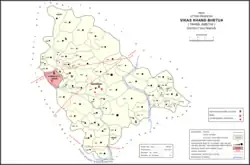Tikri | |
|---|---|
Village | |
 Map showing Tikri (#450) in Bhetua CD block | |
 Tikri Location in Uttar Pradesh, India | |
| Coordinates: 26°12′33″N 81°53′31″E / 26.209259°N 81.892049°E[1] | |
| Country | |
| State | Uttar Pradesh |
| Division | Faizabad division |
| District | Amethi |
| Area | |
| • Total | 9.002 km2 (3.476 sq mi) |
| Population (2011)[2] | |
| • Total | 7,165 |
| • Density | 800/km2 (2,100/sq mi) |
| Languages | |
| • Official | Hindi, Urdu |
| Time zone | UTC+5:30 (IST) |
Tikri is a village in Bhetua block of Amethi district, Uttar Pradesh, India.[2] As of 2011, it has a population of 7,165 people, in 1,142 households.[2] It has 3 primary schools and no healthcare facilities and does not host a weekly haat or permanent market.[2] It belongs to the nyaya panchayat of Amey Maphi.[3]
The 1951 census recorded Tikri as comprising 17 hamlets, with a total population of 2,700 people (1,283 male and 1,417 female), in 555 households and 536 physical houses.[4] The area of the village was given as 2,453 acres.[4] 19 residents were literate, all male.[4] The village was listed as belonging to the pargana of Amethi and the thana of Raipur.[4] The village had a district board-run primary school with 99 students in attendance as of 1 January 1951.[4]
The 1961 census recorded Tikri as comprising 17 hamlets, with a total population of 2,835 people (1,353 male and 1,482 female), in 588 households and 562 physical houses.[5] The area of the village was given as 2,453 acres and it had a post office at that point.[5]
The 1981 census recorded Tikri as having a population of 3,853 people, in 789 households, and having an area of 909.77 hectares.[6] The main staple foods were listed as wheat and rice.[6]
The 1991 census recorded Tikri (as "Tikree") as having a total population of 4,627 people (2,359 male and 2,268 female), in 915 households and 910 physical houses.[3] The area of the village was listed as 910.00 hectares.[3] Members of the 0-6 age group numbered 881, or 19% of the total; this group was 56% male (495) and 44% female (386).[3] Members of scheduled castes numbered 1,055, or 23% of the village's total population, while no members of scheduled tribes were recorded.[3] The literacy rate of the village was 40% (1,124 men and 382 women, counting only people age 7 and up).[3] 1,401 people were classified as main workers (1,176 men and 225 women), while 121 people were classified as marginal workers (5 men and 116 women); the remaining 3,105 residents were non-workers.[3] The breakdown of main workers by employment category was as follows: 974 cultivators (i.e. people who owned or leased their own land); 267 agricultural labourers (i.e. people who worked someone else's land in return for payment); 8 workers in livestock, forestry, fishing, hunting, plantations, orchards, etc.; 0 in mining and quarrying; 11 household industry workers; 7 workers employed in other manufacturing, processing, service, and repair roles; 2 construction workers; 31 employed in trade and commerce; 14 employed in transport, storage, and communications; and 87 in other services.[3]
References
- ↑ "Geonames Search". Do a radial search using these coordinates here.
- 1 2 3 4 5 "Census of India 2011: Uttar Pradesh District Census Handbook - Sultanpur, Part A (Village and Town Directory)" (PDF). Census 2011 India. pp. 226–42. Retrieved 25 December 2021.
- 1 2 3 4 5 6 7 8 Census 1991 Series-25 Uttar Pradesh Part-XII B Village & Townwise Primary Census Abstract District Census Handbook District Raebareli (PDF). 1992. pp. xxiv–xxviii, 140–1. Retrieved 25 December 2021.
- 1 2 3 4 5 Census of India, 1951: District Census Handbook Uttar Pradesh (49 - Rae Bareli District) (PDF). Allahabad. 1955. pp. 104–5, 198. Retrieved 25 December 2021.
{{cite book}}: CS1 maint: location missing publisher (link) - 1 2 Census 1961: District Census Handbook, Uttar Pradesh (44 - Sultanpur District) (PDF). Lucknow. 1965. pp. xlvi–xlvii. Retrieved 25 December 2021.
{{cite book}}: CS1 maint: location missing publisher (link) - 1 2 Census 1981 Uttar Pradesh: District Census Handbook Part XIII-A: Village & Town Directory, District Rae Bareli (PDF). 1982. pp. 104–5. Retrieved 25 December 2021.